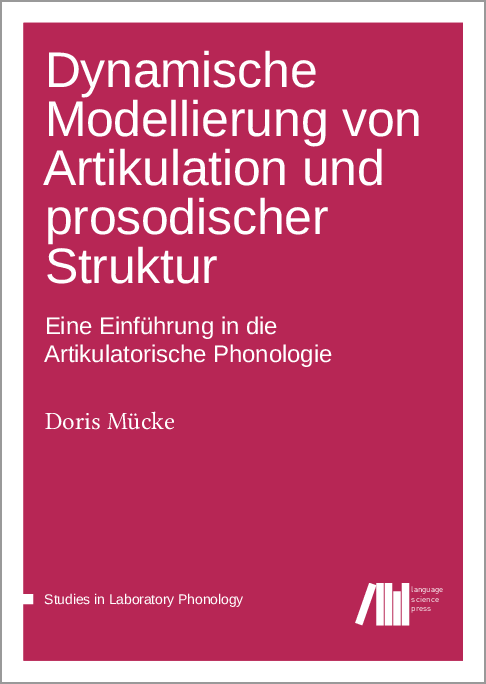We log anonymous usage statistics. Please read the privacy information for details.
Dynamische Modellierung von Artikulation und prosodischer Struktur: Eine Einführung in die Artikulatorische Phonologie
Synopsis
Die Artikulatorische Phonologie (Catherine Browman und Louis Goldstein) wurde als Alternative zu segmentalen Ansätzen entwickelt. So nimmt die segmentale Phonologie an, dass nur distinkte Information gespeichert wird, die dann mit Hilfe von Regeln und Rechenprinzipien von der kategorialen Welt der Symbole in die kontinuierliche Welt der physikalischen Repräsentation übersetzt wird. Die Artikulatorische Phonologie hingegen nimmt an, dass auch kontinuierliche Information wie beispielsweise sprecher- oder situationsbedingte Variationen als Teil des Sprachsystems gespeichert werden. Variabilität wird hier als Teil des linguistischen Systems betrachtet, das konkret Aufschluss über zugrundeliegende Strukturen gibt. Im Modell der Artikulatorischen Phonologie wird Sprache als dynamisches System betrachtet und somit phonetische und phonologische Information integriert.
Die Grundeinheiten der Artikulatorischen Phonologie sind nicht Segmente oder Merkmale, sondern artikulatorische Gesten. Diese legen linguistische relevante Konstriktionen wie beispielsweise einen Vollverschluss der Zungenspitze an den Alveolen sowie eine glottale Öffnungsgeste für Stimmlosigkeit bei der Produktion von /t/. Die Einbeziehung der zeitlichen Domäne ermöglicht im Gegensatz zu segmentalen Ansätzen die Abbildung natürlicher Variabilität. So kann beispielsweise im Falle von /t/ der Grad der Aspiration direkt aus der zeitlichen Anordnung der glottalen und oralen Geste abgeleitet werden: Ist die glottale Geste länger als die Zungenspitzengeste aktiviert, so entsteht auf akustischer Oberfläche Aspiration. Artikulatorische Gesten enkodieren darüber hinaus den kontextuellen Einfluss (Koartikulation in Form von Synergien zwischen Organgruppen) und können direkt den Einfluss höhere linguistischer Strukturen wie der prosodischen Hierarchie abbilden.
Das vorliegende Buch stellt eine Einführung in die Artikulatorische Phonologie dar. Es richtet sich an Leserinnen und Leser, die phonetische Grundkenntnisse besitzen und sich mit der Artikulatorischen Phonologie beschäftigen. Darüber hinaus werden neben einer Einführung in das Model auch neuere Arbeiten und aktuelle Weiterentwicklungen aufgezeigt, insbesondere die Implementierung prosodischer Aspekte in die Artikulatorische Phonologie. Somit eignet sich das Buch auch für Leserinnen und Leser, die bereits mit der Artikulatorischen Phonologie in Kontakt gekommen sind, aber ihr Wissen vertiefen möchten. Zur Veranschaulichung werden Beispiele aus verschiedenen Sprachen gegeben, darunter Deutsch, Katalanisch, Italienisch, Polnisch, Mandarin und Tashlhiyt Berber.
This book is an introduction to Articulatory Phonology with a special focus on the interplay of articulation and prosody. Articulatory Phonology (Catherine Browman and Louis Goldstein) is a dynamic approach that fully integrates phonetics and phonology. It assumes that the basic units of speech production are dynamically defined articulatory gestures, which can be modelled as a constellation of invariant functional units of vocal tract constriction actions. Articulatory gestures do not directly correspond to traditional segments or features. Moreover, they are movements which extend over time and can temporally overlap with one another. Within this model, the continuous variation of a self-organised speech system can be modelled, constantly mediating between the demands of the physical control system and linguistic structure.
The present book gives an introduction in German to the basic concepts of articulatory phonology for a German readership (e.g. task dynamics, definition of articulatory gestures, gestural scores, coupling graphs and parameter manipulation in mass-spring models). Furthermore, it discusses the implementation of prosodic structure in Articulatory Phonology (e.g. self-organisation of prosodic constituents, head and edge marking in the prosodic hierarchy and implementation of prosodic gestures and tone gestures in Articulatory Phonology). In every chapter, examples from different languages are given, such as German, Catalan, Italian, Polish, Mandarin und Tashlhiyt Berber.
The book is written in the spirit that dynamic approaches offer a crucial alternative to the traditional symbol-based theories. The natural process of human communication constantly triggers and constrains variation in speech, often reaching deeply into human physiology, cognition and grammar. This variation is more than just noise in experimental data: It is a window to linguistic structure, which can be best modelled in terms of a dynamical system.
Der Preis dieses Buches in Deutschland ist auf 40 EUR festgelegt.
As per legal requirement, we state that this book is available in Germany for 40 EUR.

Downloads
- Manuscript mit Quelldateien Muecke Manuscript mit Quelldateien Muecke
- Complete book Complete book



